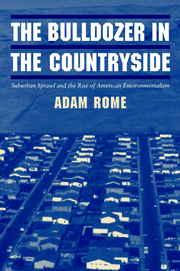Book contents
- Frontmatter
- Contents
- List of Illustrations
- Preface
- Acknowledgments
- Introduction
- 1 Levitt's Progress: The Rise of the Suburban-Industrial Complex
- 2 From the Solar House to the All-Electric Home: The Postwar Debates over Heating and Cooling
- 3 Septic-Tank Suburbia: The Problem of Waste Disposal at the Metropolitan Fringe
- 4 Open Space: The First Protests against the Bulldozed Landscape
- 5 Where Not to Build: The Campaigns to Protect Wetlands, Hillsides, and Floodplains
- 6 Water, Soil, and Wildlife: The Federal Critiques of Tract-House Development
- 7 Toward a Land Ethic: The Quiet Revolution in Land-Use Regulation
- Conclusion
- Selected Bibliography
- Index
- Plate section
5 - Where Not to Build: The Campaigns to Protect Wetlands, Hillsides, and Floodplains
Published online by Cambridge University Press: 05 December 2013
- Frontmatter
- Contents
- List of Illustrations
- Preface
- Acknowledgments
- Introduction
- 1 Levitt's Progress: The Rise of the Suburban-Industrial Complex
- 2 From the Solar House to the All-Electric Home: The Postwar Debates over Heating and Cooling
- 3 Septic-Tank Suburbia: The Problem of Waste Disposal at the Metropolitan Fringe
- 4 Open Space: The First Protests against the Bulldozed Landscape
- 5 Where Not to Build: The Campaigns to Protect Wetlands, Hillsides, and Floodplains
- 6 Water, Soil, and Wildlife: The Federal Critiques of Tract-House Development
- 7 Toward a Land Ethic: The Quiet Revolution in Land-Use Regulation
- Conclusion
- Selected Bibliography
- Index
- Plate section
Summary
“The great issue in planning is not where to build,” planner S. B. Zisman wrote in 1965, “but where not to build.”
With that dictum, Zisman summarized a dramatic change in the planning profession. For decades, the principal task of urban planners was to decide where to allow residential, commercial, and industrial development. What areas should be restricted in use, and what areas should be open to all forms of building? On planning and zoning maps, a different color represented each type of land use, while open space – as yet unzoned and undeveloped – was typically white. But the explosive growth of suburbia after World War II changed the way planners thought about the white spaces on city maps. Year after year, as cities consumed more land, people began to appreciate the value of open space. “The chief lesson to be learned,” Zisman argued, “is that open space is a functional land use – open space is not the left-over land, or the vacant land, the unused land or the waste land. It is of an equal order of consideration with any kind of development.” That meant that planners now needed to ask a new question. What sites were more valuable as open space than as subdivisions, shopping centers, or factories?
- Type
- Chapter
- Information
- The Bulldozer in the CountrysideSuburban Sprawl and the Rise of American Environmentalism, pp. 153 - 188Publisher: Cambridge University PressPrint publication year: 2001
- 1
- Cited by

